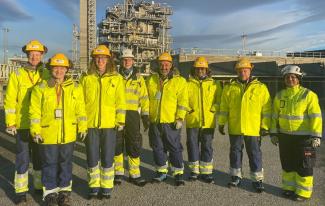Completing an 8,000-mile business trip in just six days can be daunting, but the journey was well worth the effort for a contingent from NETL and the U.S. Department of Energy’s (DOE) Office of Fossil Energy and Carbon Management (FECM) to ensure key projects supported by NETL remain on track to capture greenhouse gas from industrial sources.
The focus of the trip was the opportunity to meet with partners at the Technology Centre Mongstad (TCM). Located in Norway, TCM is the world’s largest open-access test center for developing carbon capture technologies, which are crucial to reduce emissions of carbon dioxide (CO2) and address climate change.
“This technical deep dive at TCM was valuable because it allowed us to learn directly from the on-site researchers about how these critical projects are progressing and what we can do to help address any challenges to make certain this research remains on schedule to develop effective, low-cost decarbonization solutions,” said Katharina Daniels, a federal project manager on NETL’s Point Source Carbon Capture (PSCC) Team.
The FECM PSCC Program includes efforts to use advanced CO2 capture media (solvents, sorbents and membranes) to separate CO2 from flue gas generated by fossil energy plants and difficult-to-decarbonize industries such as steel, iron and cement production. The captured carbon can then be sequestered in the subsurface or used as a feedstock to manufacture value-added products and chemicals.
TCM is a unique facility that draws carbon emissions from two adjacent facilities — an oil refinery with a catalytic cracker and a natural gas-burning combined heat and power plant. Those two sources allow TCM to simulate different kinds of real-world emissions to test carbon capture technologies.
Daniels said the DOE/NETL contingent spent a portion of its TCM visit touring a test unit developed by industry partner InnoSepra Inc. The technology, which received $4 million in DOE research funding and is managed by NETL, is a transformational sorbent-based process designed to significantly reduce CO2 capture costs from power plant and industrial flue gases.
“At the end of the tour, we met with TCM and InnoSepra personnel to provide our insights and expedite the test campaign going forward to achieve its targets,” Daniels said.
A representative of ION Clean Energy Inc. led a tour of a test unit at TCM where ION is testing and scaling up the ICE-31 solvent. Through a series of projects made possible with DOE funding and NETL oversight, the company has matured this carbon capture system from early-stage research to pilot-scale testing.
During time spent at TCM, NETL’s Ron Munson, technology manager, Carbon Capture, led a presentation on the FECM PSCC Program.
DOE/NETL enjoys a longstanding partnership with TCM. “Their visits motivate us because they present opportunities for collaboration and to address knowledge gaps,” said Christina Martavaltzi, TCM business development manager.
“TCM and DOE have collaborated on several important projects during the past seven years to accelerate de-risking, scale-up and commercialization of carbon capture technologies, and we are looking forward to continuing this collaboration to accelerate deployment of these technologies to help achieve decarbonization goals,” said Ismail Shah, TCM managing director.
“During this latest visit, we were excited to hear about the fantastic program that DOE and NETL have put together to boost all parts of the carbon capture and storage value chain. We also discussed how we can combine our capabilities to improve amine modeling and use artificial intelligence to develop accurate emission predictions. There is so much potential when our great teams work together,” Martavaltzi said.
Daniels said several members of the DOE/NETL contingent also toured SINTEF, one of Europe’s largest independent research organizations, in Trondheim, Norway, before making the long flight back to the United States.
NETL is a U.S. Department of Energy national laboratory that drives innovation and delivers technological solutions for an environmentally sustainable and prosperous energy future. By leveraging its world-class talent and research facilities, NETL is ensuring affordable, abundant and reliable energy that drives a robust economy and national security, while developing technologies to manage carbon across the full life cycle, enabling environmental sustainability for all Americans.




